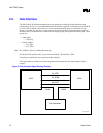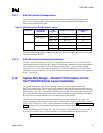
Intel
®
820E Chipset
R
72 Design Guide
2.8.12. AGP Universal Retention Mechanism (RM)
Environmental testing and field reports indicate that, without proper retention, AGP cards and AGP
In-Line Memory Module (AIMM) cards may come unseated during system shipping and handling. In
order to prevent the disengagement of AGP cards and AIMM modules, Intel recommends that AGP-
based platforms use the AGP retention mechanism (RM).
The AGP RM is a mounting bracket used to properly locate the card with respect to the chassis and to
assist with card retention. The AGP RM is available in two different handle orientations: left-handed (see
Figure 40) and right-handed. Most system boards accommodate the left-handed AGP RM. Because the
manufacturing capacity is greater for the left-handed RM, Intel recommends that customers design into
their systems the left-handed AGP RM (Figure 41). The right-handed AGP RM is identical to the left-
handed AGP RM, except for the position of the actuation handle, which is located on the same end as in
the primary design, but extends from the opposite side, parallel to the longitudinal axis of the part. Figure
41 details the keep-out information for the left-handed AGP RM. Use this information to ensure that your
motherboard design leaves adequate space for RM installation.
The AGP interconnect design requires that the AGP card be retained so as to limit card back-out within
the AGP connector to 0.99 mm (0.039 in.) max. For this reason, new cards should have an additional
mechanical keying tab notch, which provides an anchor point on the AGP card for interfacing with the
AGP RM. The RM’s round peg engages with the AGP or AIMM card’s retention tab, thereby preventing
the card from disengaging during dynamic loading. The additional notch in the mechanical keying tab is
required for 1.5 V AGP cards and is recommended for the new 3.3 V AGP cards.
Figure 40. AGP Left-Handed Retention Mechanism


















